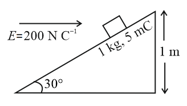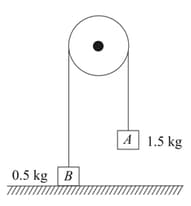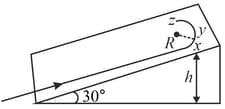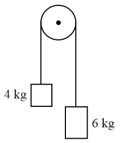Starting from rest, a body slides down a 45° inclined plane in twice the time it takes to slide down the same distance in the absence of friction. The coefficient of friction between the body and the inclined plane is
Important Questions on Newton's Laws of Motion

An inclined plane making an angle of with the horizontal is placed in a uniform horizontal electric field as shown in the figure. A body of mass and charge is allowed to slide down from rest at a height of . If the coefficient of friction is find the time taken by the body to reach the bottom.


Two blocks and of masses and respectively are connected by a massless inextensible string passing over a frictionless pulley as shown in the figure. Block A is lifted until block B touches the ground and then block A is released. The initial height of block A is when block B just touches the ground. The maximum height reached by block from the ground after the block A falls on the ground is

A student skates up a ramp that makes an angle with the horizontal. He/she starts (as shown in the figure) at the bottom of the ramp with speed and wants to turn around over a semicircular path of radius during which he/she reaches a maximum height (at point ) from the ground as shown in the figure. Assume that the energy loss is negligible and the force required for this turn at the highest point is provided by his/her weight only. Then ( is the acceleration due to gravity)


A long slope makes an angle with the horizontal. box of mass is pulled up the slope by a rope that is parallel to the slope. The coefficient of friction between the box and the slope is At the top of the slope, the rope passes over a smooth pulley. A ball of mass hangs from the other end of the rope. The ball is initially above the ground. The system is released from rest.
Find how long it will take for the box to travel up the slope.

A block of mass is pulled up a hill in the line of greatest slope by a force of magnitude acting at an angle above the hill. The block passes through points and with speeds and respectively (see diagram). The distance is and is above the level of The resistance to motion of the block is Find the value of

